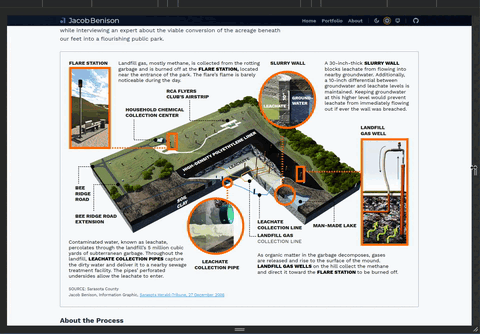Visualizing a landfill conversion
December 27, 2006
Working as a graphic designer for a news organization sometimes means venturing into unexpected situations, such as climbing a giant mound of garbage while interviewing an expert about the viable conversion of the acreage beneath our feet into a flourishing public park. 1 Landfill gas, mostly methane, is collected from the rotting garbage and is burned off at the FLARE STATION, located near the entrance of the park. The flare’s flame is barely noticeable during the day. ↑ 2 A 30-inch-thick SLURRY WALL blocks leachate from flowing into nearby groundwater. Additionally, a 10-inch differential between groundwater and leachate levels is maintained. Keeping groundwater at this higher level would prevent leachate from immediately flowing out if ever the wall was breached. ↑ 3 HIGH-DENSITY POLYETHYLENE LINER ↑ 4 LEACHATE ↑ 5 LEACHATE COLLECTION LINE ↑ 6 As organic matter in the garbage decomposes, gases are released and rise to the surface of the mound. LANDFILL GAS WELLS on the hill collect the methane and direct it toward the FLARE STATION to be burned off. ↑ 7 LANDFILL GAS COLLECTION LINE ↑ 8 Contaminated water, known as leachate, percolates through the landfill’s 5 million cubic yards of subterranean garbage. LEACHATE COLLECTION PIPE throughout the landfill capture the dirty water and deliver it to a nearby sewage treatment facility. The pipes’ perforated undersides allow the leachate to enter. ↑

About the process
- Research and Interviews: To ensure the accuracy and depth of the information portrayed in the infographic, I conducted extensive research. Interviews with experts were crucial in gathering insights into sustainable practices planned by Sarasota County for this project. Their knowledge shaped the narrative and eventually communicated through visuals.
- Source Material Gathering: The next step was to transform raw data and rudimentary diagrams from the county’s plan into visuals that would resonate with the audience. I used the provided source materials to create illustrations that vividly depicted the various aspects of the landfill conversion process.
- 3D Modeling: Creating vivid representations of critical mechanisms installed beneath the visible surface allowed viewers to grasp how the county could accomplish such a transformation of land use.
- Layout & Design: Balancing information with aesthetics, the design aimed to guide the viewer through the narrative.
- HTML/SVG Markup: Taking the project further, I transformed this infographic for my portfolio from a static image designed for newspaper printing to a responsive web graphic. Leveraging HTML, CSS, and SVG markup, the design adapts to various screen sizes and devices, ensuring an optimal viewing experience for diverse audiences.